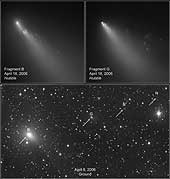|
COMETS EARTH JUPITER KUIPER BELT MARS MERCURY METEORITES NEPTUNE OORT CLOUD PLUTO SATURN SOLAR SYSTEM SPACE SUN URANUS VENUS ORDER PRINTS
PHOTO CATEGORIES SCIENCEVIEWS AMERICAN INDIAN AMPHIBIANS BIRDS BUGS FINE ART FOSSILS THE ISLANDS HISTORICAL PHOTOS MAMMALS OTHER PARKS PLANTS RELIGIOUS REPTILES SCIENCEVIEWS PRINTS
|
Related Documents
Download Options
Hubble Space Telescope is providing astronomers with extraordinary views of Comet 73P/Schwassmann-Wachmann 3. The fragile comet is rapidly disintegrating as it approaches the Sun. Hubble images have uncovered many more fragments than have been reported by ground-based observers. These observations provide an unprecedented opportunity to study the demise of a comet nucleus. The comet is currently a chain of over three dozen separate fragments, named alphabetically, stretching across the sky by several times the angular diameter of the Moon. Hubble caught two of the fragments (B and G) shortly after large outbursts in activity. Hubble shows several dozen "mini-comets" trailing behind each main fragment, probably associated with the ejection of house-sized chunks of surface material. Deep-freeze relics of the early solar system, cometary nuclei are porous and fragile mixes of dust and ices that can break apart due to the thermal, gravitational, and dynamical stresses of approaching the Sun. Whether any of the many fragments survive the trip around the Sun remains to be seen in the weeks ahead. |
